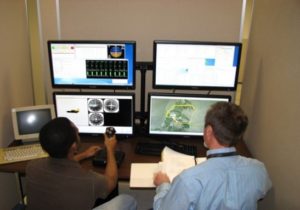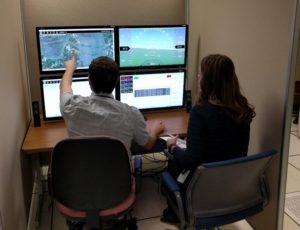Uninhabited Aircraft Systems (UAS) Integration and Validation Laboratory (SIVL) provides a UAS-systems integration, validation, and diagnostics hardware-in-the-loop simulation capability to facilitate safety studies of UAS systems on typical UAS missions. This laboratory is capable of providing a full systems simulation of a variety of UAS down to the subsystem and component level and includes a hardware-in-the-loop capability. The simulation includes full mathematical models of the vehicle dynamics, vehicle mass properties, aerodynamic system, control system, propulsion system, power systems, and avionics systems, including sensors and auto flight systems. The simulation design allows the controlled insertion of a wide variety of fault options, failure modes, fault timing, variable latencies, and other features to facilitate research to be conducted for wide-ranging analyses of typical UAS systems. A robust data collection system provides full visibility into failure modes, propagation, and effects, and the reconstruction of events of interest. SIVL capabilities include software representations of different types of UAS having a wide range of performance capabilities, commonly-used hardware interfaces, command and control links, and a generic enclosed ground control station. SIVL also includes network interfaces that will allow the integration of its capability into other larger scale simulations or the remote operation of the simulation.
SIVL provides a robust and flexible simulation framework that enables the study of failure modes, effects, propagation paths, criticality, and mitigation strategies to help address issues associated with UAS avionics and flight control system reliability, safety assessment methodologies, and functional hazard identification in order to develop safety, reliability, and design data that can assist with the development of certification standards, means of compliance, and design best practices for UAS. The robust design of the simulation capability will also permit other uses, such as helping to establish safety cases for NASA or other UAS projects prior to flight.
GENERIC GROUND CONTROL STATION
Beyond visual line-of-sight operations
- Open source ground control station software
- Communication link between GCS and simulation computer
– Download flight plan to GCS
– Upload modified flight plan to simulation
– Display simulated vehicle flight path on GCS display
– Allows for easy integration of different GCS or handoff between multiple station - User definable displays
- User supplied inceptors
- User GCS can be substituted
- Allows hand-offs to/from Generic GCS and visual inner loop control of UAS
MULTI-UAV CONTROL CAPABILITY
- Multiple simulated UAVs controllable simultaneously
– Synchronous flight plan upload and download
– Modify flight plans on-the-fly
– Ground station based on APM Planner 2.0, Mavlink
– Multiple ground stations can interface with UAVs simultaneously - PFD, satellite map, raw data displays available for each UAV
- UAVs protected from unintentional flight plan changes
- Integration with Live Virtual Constructive distributed traffic data
FACILITY BENEFITS
- Robust and flexible simulation environment that permits the study of failure modes, effects, propagation paths, criticality, and mitigation strategies SW-centric with HWITL capability
- Representative UAS integrated avionics system
- Representative UAS Actuators
- Modifiable UAV, flight controls, and engine dynamics
RESEARCH STUDIES IN SIVL
- Human factor considerations that include collision detection, visual, audible intruder aircraft detection, and control of small UAS during Visual Line of Sight operation
- Avionics and software interface for autopilot, communications, and data collection for UAV such as GL-10 and Learn-to-Fly airplane models
- Performance and safety requirements for UAV operating in restricted “geo-fencing” containment environments

